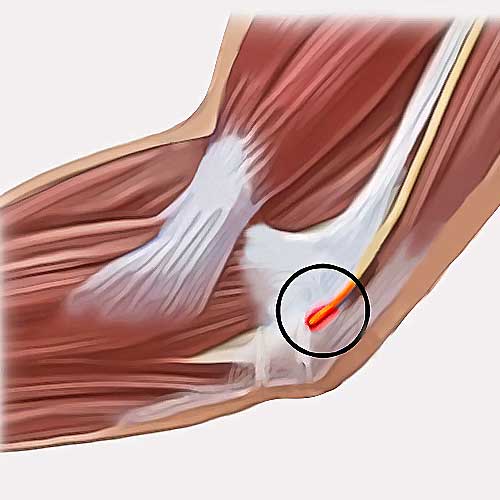
Cubital tunnel syndrome is compression of the ulnar nerve on the medial side of the elbow.
Cubital tunnel syndrome, also known as ulnar neuropathy or ulnar nerve entrapment, is a condition that affects the ulnar nerve as it passes through the cubital tunnel in the elbow. The ulnar nerve is one of the major nerves of the arm and provides sensation to the little finger and half of the ring finger, as well as controls certain muscles of the hand.
In cubital tunnel syndrome, the ulnar nerve becomes compressed or irritated as it passes through the cubital tunnel, which is a narrow passageway formed by bone, ligaments, and other soft tissues on the inside of the elbow. The compression can occur due to various reasons, including:
Pressure or Prolonged Flexion: Keeping the elbow flexed for prolonged periods, such as during sleep or with repetitive bending of the elbow, can increase pressure on the ulnar nerve.
Direct Pressure: Resting the elbow on hard surfaces or frequently leaning on the elbow can directly compress the nerve.
Anatomical Abnormalities: Some individuals may have anatomical variations that predispose them to cubital tunnel syndrome, such as a naturally smaller or tighter cubital tunnel or prominent bony structures in the area.
Repetitive Movements: Repetitive activities that involve bending or twisting of the elbow can contribute to nerve irritation and compression.
Symptoms
The symptoms of cubital tunnel syndrome may include:
- Numbness or tingling in the ring finger and little finger.
- Weakness in the hand, especially in the muscles controlling fine movements, like gripping or pinching.
- Difficulty with finger coordination or clumsiness.
- Pain or discomfort in the elbow or forearm.
The severity of symptoms can vary depending on the extent of nerve compression and individual factors. In some cases, symptoms may worsen over time, and this may lead to muscle wasting or loss of grip strength.
Cubital Tunnel Syndrome Treatment
Treatment for cubital tunnel syndrome aims to relieve pressure on the ulnar nerve and manage symptoms. Non-surgical treatment options may include:
- Avoiding activities that aggravate symptoms and modifying work or daily habits.
- Wearing a splint or brace to keep the elbow in a neutral position, especially at night.
- Physical therapy exercises to improve elbow strength and flexibility.
- Anti-inflammatory medications or corticosteroid injections to reduce nerve inflammation and pain.
If conservative measures fail to provide sufficient relief or if the condition is severe, surgery may be recommended. Surgery for cubital tunnel syndrome involves releasing or decompressing the ulnar nerve, repositioning the nerve, or addressing any contributing structural abnormalities.
